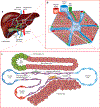Cell and Tissue Therapy for the Treatment of Chronic Liver Disease
- PMID: 33974812
- PMCID: PMC8864721
- DOI: 10.1146/annurev-bioeng-112619-044026
Cell and Tissue Therapy for the Treatment of Chronic Liver Disease
Abstract
Liver disease is an important clinical problem, impacting 600 million people worldwide. It is the 11th-leading cause of death in the world. Despite constant improvement in treatment and diagnostics, the aging population and accumulated risk factors led to increased morbidity due to nonalcoholic fatty liver disease and steatohepatitis. Liver transplantation, first established in the 1960s, is the second-most-common solid organ transplantation and is the gold standard for the treatment of liver failure. However, less than 10% of the global need for liver transplantation is met at the current rates of transplantation due to the paucity of available organs. Cell- and tissue-based therapies present an alternative to organ transplantation. This review surveys the approaches and tools that have been developed, discusses the distinctive challenges that exist for cell- and tissue-based therapies, and examines the future directions of regenerative therapies for the treatment of liver disease.
Keywords: cell therapy; liver; stem cell biology; tissue engineering.
Figures



References
-
- Marcellin P, Kutala BK. 2018. Liver diseases: a major, neglected global public health problem requiring urgent actions and large-scale screening. Liver Int. 38:2–6 - PubMed
-
- Sepanlou SG, Safiri S, Bisignano C, Ikuta KS, Merat S, et al. 2020. The global, regional, and national burden of cirrhosis by cause in 195 countries and territories, 1990–2017: a systematic analysis for the Global Burden of Disease Study 2017. Lancet Gastroenterol. Hepatol 5(3):245–66 - PMC - PubMed
-
- Asrani SK, Devarbhavi H, Eaton J, Kamath PS. 2019. Burden of liver diseases in the world. J. Hepatol 70:151–71 - PubMed
Publication types
MeSH terms
Grants and funding
LinkOut - more resources
Full Text Sources
Other Literature Sources
Medical
Miscellaneous

